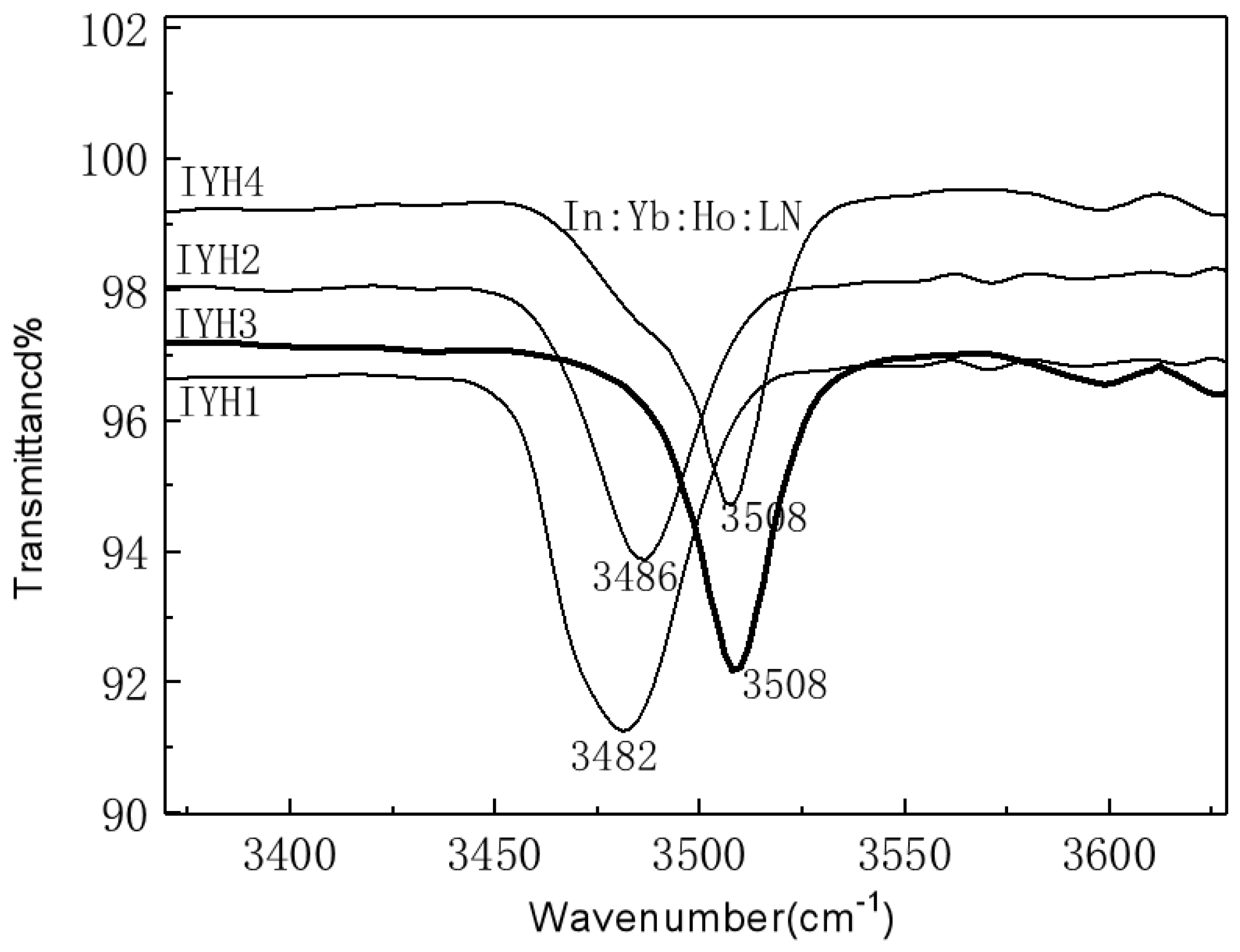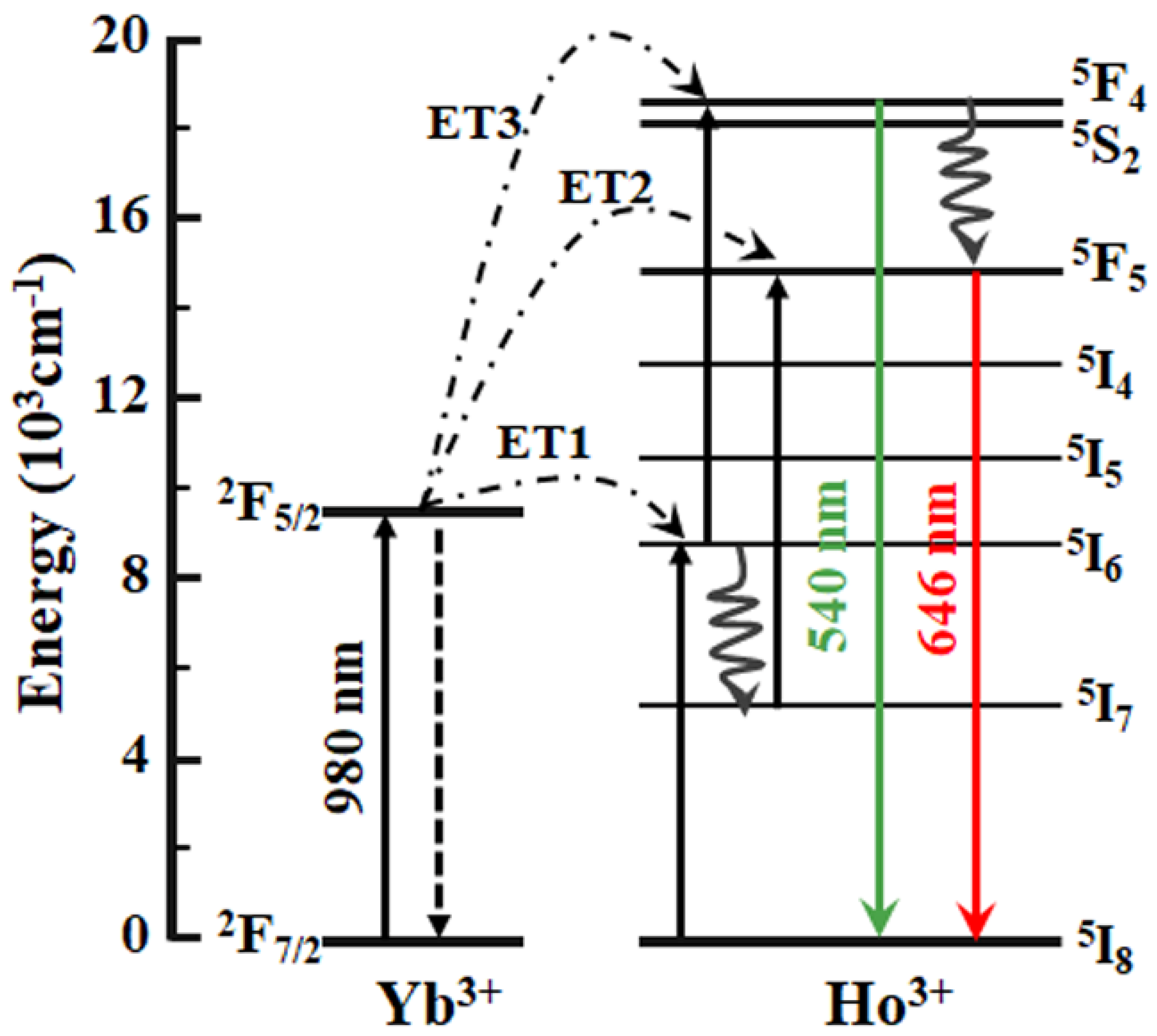Defect Structure and Upconversion Luminescence Properties of LiNbO3 Highly Doped Congruent In:Yb:Ho:LiNbO3 Crystals
Abstract
:1. Introduction
2. Experiment
2.1. Growth of the In:Yb:Ho:LiNbO3 Crystal
2.2. Spectroscopic Measurements
3. Results and Discussions
3.1. IR Transmittance Spectra Analysis
3.2. Up Conversion Process of In:Yb:Ho:LiNbO3
3.3. Mechanism of Upconversion Emissions
4. Conclusions
Author Contributions
Funding
Institutional Review Board Statement
Informed Consent Statement
Data Availability Statement
Acknowledgments
Conflicts of Interest
References
- Eyring, L.; Gschneidner, K.A.; Lander, G.H. Handbook on the Physics and Chemistry of Rare Earths. 2001. Available online: https://www.elsevier.com/books/handbook-on-the-physics-and-chemistry-of-rare-earths/eyring/978-0-444-50762-4 (accessed on 10 February 2022).
- Bhatt, R.; Kar, S.; Bartwal, K.S.; Wadhawan, V.K. The effect of Cr doping on optical and photoluminescence properties of LiNbO3 crystals. Solid State Commun. 2003, 127, 457–462. [Google Scholar] [CrossRef]
- Ryba-Romanowski, W.; Golab, S.; Dominiak-Dzik, G.; Solarz, P.; Lukasiewicz, T. Conversion of infrared radiation into red emission in YVO4:Yb,Ho. Appl. Phys. Lett. 2001, 79, 3026–3028. [Google Scholar] [CrossRef]
- Qiu, J.; Shojiya, M.; Kawamoto, Y. Sensitized Ho3+ up-conversion luminescence in Nd3+-Yb3+-Ho3+ co-doped ZrF4-based glass. J. Appl. Phys. 1999, 86, 909–913. [Google Scholar] [CrossRef]
- Auzel, F. Upconversion and anti-Stokes processes with f and d ions in solids. Cheminform 2004, 35, 139. [Google Scholar] [CrossRef]
- Chen, G.; Yang, L.; Chao, X.; Hao, S.; Qiu, H.; Liang, S.; Xu, Y.; Yang, C. Generation of 1.5 μm emission through an upconversion-mediated looping mechanism in Er3+/Sc3+-codoped LiNbO3 single crystal. Opt. Lett. 2012, 37, 1268. [Google Scholar] [CrossRef]
- Rodenas, A.; Garcia, J.; Jaque, D.; Torchia, G.A.; Mendez, C.; Arias, I.; Roso, L.; Agullo-Rueda, F. Optical investigation of femtosecond laser induced microstress in neodymium doped lithium niobate crystals. J. Appl. Phys. 2006, 100, 1695. [Google Scholar] [CrossRef]
- Jaque, D.; Chen, F.; Tan, Y. Scanning confocal fluorescence imaging and micro-Raman investigations of oxygen implanted channel waveguides in Nd:MgO:LiNbO3. Appl. Phys. Lett. 2008, 92, 253. [Google Scholar] [CrossRef]
- Rodenas, A.; Maestro, L.M.; Ramirez, M.O.; Torchia, G.A.; Jaque, D. Anisotropic lattice changes in femtosecond laser inscribed Nd3+:MgO:LiNbO3 optical waveguides. J. Appl. Phys. 2009, 106, 013110. [Google Scholar] [CrossRef]
- Gouveianeto, A.S.; Bueno, L.A.; Do Nascimento, R.F.; Da Silva, E.A.; Da Costa, E.B.; Do Nascimento, V.B. White light generation by frequency upconversion in Tm3+/Ho3+/Yb3+-codoped fluorolead germanate glass. Appl. Phys. Lett. 2007, 91, 091114. [Google Scholar] [CrossRef]
- Hewes, R.A. Multiphoton excitation and efficiency in the Yb3+-R.E.3+ (Ho3+, Er3+, Tm3+) systems. J. Lumin. 1970, 1, 778–796. [Google Scholar] [CrossRef]
- Zhen, X.H.; Li, H.T.; Sun, Z.J.; Ye, S.J.; Zhao, L.C.; Xu, Y.H. Defect structure and optical damage resistance of Mg:Mn:Fe:LiNbO3 crystals. J. Phys. D Appl. Phys. 2004, 37, 634. [Google Scholar] [CrossRef]
- Fan, Y.; Xia, S.; Yu, Z.; Zheng, W.; Sun, F. Defect structure and increased photorefractive damage resistance of ZnO highly doped congruent LiNbO3:Ho:Yb single crystals. Opt. Commun. 2013, 291, 313–316. [Google Scholar] [CrossRef]
- Xu, Z.; Xu, S.; Jian, Z.; Liu, X.; Xu, Y. Growth and photorefractive properties of In:Fe:LiNbO3 crystals with various [Li]/[Nb] ratios. J. Cryst. Growth 2005, 280, 227–233. [Google Scholar] [CrossRef]
- Kong, Y.; Xu, J.; Zhang, W.; Zhang, G. The site occupation of protons in lithium niobate crystals. J. Phys. Chem. Solids 2000, 61, 1331–1335. [Google Scholar] [CrossRef]
- Herrington, J.R.; Dischler, B.; Räuber, A.; Schneider, J. An optical study of the stretching absorption band near 3 microns from OH-defects in LiNbO3. Solid State Commun. 1973, 12, 351–354. [Google Scholar] [CrossRef]
- Kong, Y.; Deng, J.; Zhang, W.; Wen, J.; Zhang, G.; Wang, H. OH absorption spectra in doped lithium niobate crystals. Phys. Lett. A 1994, 196, 128–132. [Google Scholar] [CrossRef]
- Abrahams, S.C.; Marsh, P. Defect structure dependence on composition in lithium niobate. Acta Crystallogr. Sect. B 1986, 42, 61–68. [Google Scholar] [CrossRef]
- Chao, X.; Chun-Lei, Z.; Li, D.; Xue-Song, L.; Lei, X.; Yu-Heng, X. OH- absorption and nonvolatile holographic storage properties in Mg:Ru:Fe:LiNbO3 crystal as a function of Mg concentration. Chin. Phys. B 2013, 22, 054203. [Google Scholar] [CrossRef]
- Xing, L.; Wu, X.; Wang, R.; Xu, W.; Qian, Y. Upconversion white-light emission in Ho3+/Yb3+/Tm3+ tridoped LiNbO3 single crystal. Opt. Lett. 2012, 37, 3537–3539. [Google Scholar] [CrossRef]
- Qian, Y.; Rui, W.; Xing, L.; Xu, Y.; Yang, C.; Liu, X. Influence of Zn2+ ions concentration on the optical properties of Zn/Er:LiNbO3 crystals. Cryst. Res. Technol. 2011, 46, 1137–1142. [Google Scholar] [CrossRef]
- Qian, Y.; Wang, R.; Chao, X.; Wu, X.; Xing, L.; Xu, Y. Optical spectroscopy and laser parameters of Zn2+/Er3+/Yb3+-tridoped LiNbO3 crystal. J. Lumin. 2012, 132, 1976–1981. [Google Scholar] [CrossRef]
- Li, A.H.; Zheng, Z.R.; Lu, Q.; Sun, L.; Lu, T.Q. Sensitized holmium upconversion emission in LiNbO3 triply doped with Ho3+, Yb3+, and Nd3+. J. Appl. Phys. 2008, 104, 061108. [Google Scholar] [CrossRef]




| Sample | (mol%) | (mol%) | (mol%) | [Li/Nb]ratio | Name |
|---|---|---|---|---|---|
| IYH1 | 0 | 0.25 | 0.25 | 0.946 | Yb(0.5%):Ho(0.5%): |
| IYH2 | 0.5 | 0.25 | 0.25 | 0.946 | In(1%):Yb(0.5%):Ho(0.5%): |
| IYH3 | 1.5 | 0.25 | 0.25 | 0.946 | In(3%):Yb(0.5%):Ho(0.5%): |
| IYH4 | 1.75 | 0.25 | 0.25 | 0.946 | In(3.5%):Yb(0.5%):Ho(0.5%): |
Publisher’s Note: MDPI stays neutral with regard to jurisdictional claims in published maps and institutional affiliations. |
© 2022 by the authors. Licensee MDPI, Basel, Switzerland. This article is an open access article distributed under the terms and conditions of the Creative Commons Attribution (CC BY) license (https://creativecommons.org/licenses/by/4.0/).
Share and Cite
Xu, L.; Xu, Y.; Chen, G. Defect Structure and Upconversion Luminescence Properties of LiNbO3 Highly Doped Congruent In:Yb:Ho:LiNbO3 Crystals. Crystals 2022, 12, 710. https://doi.org/10.3390/cryst12050710
Xu L, Xu Y, Chen G. Defect Structure and Upconversion Luminescence Properties of LiNbO3 Highly Doped Congruent In:Yb:Ho:LiNbO3 Crystals. Crystals. 2022; 12(5):710. https://doi.org/10.3390/cryst12050710
Chicago/Turabian StyleXu, Lei, Yuheng Xu, and Guanying Chen. 2022. "Defect Structure and Upconversion Luminescence Properties of LiNbO3 Highly Doped Congruent In:Yb:Ho:LiNbO3 Crystals" Crystals 12, no. 5: 710. https://doi.org/10.3390/cryst12050710
APA StyleXu, L., Xu, Y., & Chen, G. (2022). Defect Structure and Upconversion Luminescence Properties of LiNbO3 Highly Doped Congruent In:Yb:Ho:LiNbO3 Crystals. Crystals, 12(5), 710. https://doi.org/10.3390/cryst12050710








